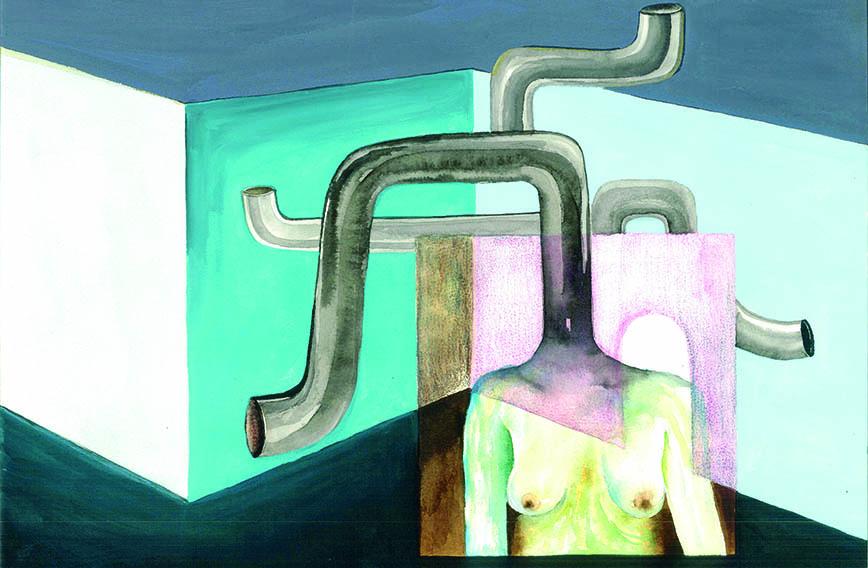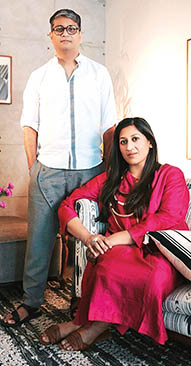
A Rupali Patil creation
Artists choose artists
Aiema Tauheed, Kolkata
ON a breezy evening we arrived in a 1930s Kolkata home in Ballygunge which has belonged to curator-writer Aveek Sen and his family for generations. French-louvre windows lined the corridor and a flight of stairs led us to a board lit up with the word Experimenter.
We were here for an exhibition, Artists for Artists, organized by Experimenter Art Gallery on its 16th anniversary, starting April 5 and ending June 14. The show features four solo projects by artists suggested by other artists from the gallery’s programme.
Art survives institutions but thrives in community, it is said.
The exhibition was born out of a simple idea: to explore the relationships artists share, as friends, collaborators, mentors, or just pillars of support.
“And what does that do to each other’s practice?” said Priyanka Raja, founder of Experimenter. “Not just to the one receiving feedback, but to the one offering it too? As a gallery, we were really interested in those relationships and moments. We began to wonder, could we build an exhibition around that? We asked three artists from our programme to think about the people whose practices they’d like to shine a light on, to come together, exchange feedback, and share that process with the world.”
This room with high ceilings and mosaic-tiled flooring featured a series of works by Rupali Patil, If we opened people up, we’d find landscapes. The title was inspired by a poem by filmmaker Agnès Varda.
Patil’s name was suggested by Rathin Barman, who trained as an engineer before becoming a sculptor. Her walkthrough with Barman was the third in the sequence of artist-led walkthroughs. She appeared alongside him, her face thoughtful and composed.
“I have admired her work for many years now. We met in Bombay about a decade ago,” said Barman, with a kind smile. She thanked him warmly for recommending her. “This programme is really special for me because friendship, caregiving and love are my language for art. As an artist, I see society and connect with it on an empathetic and personal level,” she said.
Glancing around the room, there were forms that resembled factory structures, parts of the female body and… sugarcane plants.
She pointed to the artwork titled I echo a thousand times after you, Agnes, showing sugarcane stalk-like structures. It was created using ink and acrylic on canvas. “During the pandemic, I started working on this piece. I came across an article about a sugarcane factory that was producing ethanol, and it made me nauseous. I used to wander through sugarcane factories as a child. We went on school trips to watch how sugar was made. It was a happy memory, and suddenly, it felt tainted.”
 |
|
Prateek and Priyanka Raja |
Trained in printmaking, she grew up in Pune, where local theatre circles introduced her to the work of filmmaker Agnès Varda. Nature has long found its way into her practice. She takes keen interest in themes like social issues, ecofeminism, water and mineral crises.
“After that I read an article in The Wire about women sugarcane workers. Amidst the harsh labour involved in farming, they get their periods, and because of the lack of sanitation, they really cannot maintain hygiene. That backfires on their bodies. So now, many are going through hysterectomy surgeries.”
The crowd gasped. “So, yeah, it's terrible,” she agreed, “In this painting I’m looking at how capitalism affects us, it does not allow us agency over the choices we have over our own bodies.” Patil is exploring the issues faced by female sugarcane workers, specifically in Beed district of Maharashtra, where their health is disproportionately affected.
“The Wire and P. Sainath have done great research on all these topics. But as an artist, I felt it also came from a deeply personal place, watching my own mother go through menopause. At the same time, I was reading about women being forced into menopause unnaturally, in their 30s.”
Second in the sequence was Aishwarya Arumbakkam, a Chennai-based multidisciplinary visual artist working across photography and filmmaking. She was suggested by well-known photographer Sohrab Hura.
Her works, under Ten sounds I cannot hear, presented in a dimly lit room, immediately invited intimacy. A video of an elderly woman blinking, her gaze direct and warm, titled Amma breathing, 2020-22, anchored the space. Surrounding it were monochromatic photographs printed on wrinkly paper with marks, which we learnt were intaglio on Gampi silk tissue.
 One photograph, titled Amma’s chest, 2020-2022 showed an old woman’s wrinkled chest covered in a saree. There were other candid pictures of an elderly man as well. On a nearby wall, a set of headphones hung, titled Amma in between, breathing, 2022. Visitors could wear it to hear faint ambient sounds: breathing, soft rustles, perhaps the sound of a distant room, creating an oddly intimate, almost intrusive presence.
One photograph, titled Amma’s chest, 2020-2022 showed an old woman’s wrinkled chest covered in a saree. There were other candid pictures of an elderly man as well. On a nearby wall, a set of headphones hung, titled Amma in between, breathing, 2022. Visitors could wear it to hear faint ambient sounds: breathing, soft rustles, perhaps the sound of a distant room, creating an oddly intimate, almost intrusive presence.
“It’s a body of work I made with my parents,” Arumbakkam shared. “Between 2020 and 2022, during the early days of the Covid-19 pandemic, my parents were in Chennai, and I was suddenly, and somewhat unexpectedly, living in the US. I’d been moving back and forth before that but then, I got stuck.”
She continued, “I was really anxious about leaving my parents. They were ageing, their health wasn’t great, and the separation was sudden. I’m very close to them, we used to talk all the time. Messages, WhatsApp, phone calls, all kinds of ways to stay connected.”
The title Ten sounds I cannot hear comes from a folder in Arumbakkam’s archive of photos and audio recorded with her parents over video calls during the pandemic. By turning digital moments into physical objects, she tries to shrink the distance between them and stretch the time they have left together.
 The first in the sequence of walkthroughs, Sathish Kumar, walked us through his ongoing photographic series titled Sunlight. Displayed in a brightly lit room, his monochromatic photos captured everyday objects that often go unnoticed. They stood out against pristine white walls. There was something strangely poetic about seeing dust and sunlight, a pineapple, or a lone pigeon, day-to-day moments made tender through Kumar’s lens.
The first in the sequence of walkthroughs, Sathish Kumar, walked us through his ongoing photographic series titled Sunlight. Displayed in a brightly lit room, his monochromatic photos captured everyday objects that often go unnoticed. They stood out against pristine white walls. There was something strangely poetic about seeing dust and sunlight, a pineapple, or a lone pigeon, day-to-day moments made tender through Kumar’s lens.
“For me, the camera is drawn to the ordinary, the everyday,” he said. “I started in 2020 during the lockdown, and I’ve been shooting for the past five years.” At the heart of his work is simplicity, both in subject and spirit. It reflects in how he titles his work, believing names should be straightforward and accessible to all.
Sunlight began during the pandemic, born out of confinement and anxiety. In these photos, sunlight emerged as a quiet symbol of hope, tracing his transition from the stillness of the lockdown to the slow return of life in the post-pandemic world.
Kumar too was suggested by Hura. “I appreciate that he manages to make me re-look at the world anew,” remarked Hura. He had known and admired Kumar’s works for a while so when he was asked to suggest a name, Kumar’s was the one that came up instantaneously. “He’s a photographer, and this is disappearing, this way of seeing,” he said.
“Artists have always supported one another. Personally, I received a lot of help from more experienced artists, whether through guidance or by sharing materials like film. But sometimes, we forget this spirit of solidarity, especially when more formal, robust infrastructure comes into play. It’s often a fragile ecosystem, full of insecurities, with limited opportunities and countless voices,” he noted.
At Experimenter’s Hindustan Road space, the fourth artist in the line-up was Rai, whose works were suggested by Bhasha Chakrabarti. Titled Fever, her series delved into themes of spatial negotiation, permeability, impression and erasure, as well as recollection and amnesia.
“The entire exhibition is quite a novel concept, because I haven’t heard of artists selecting artists for a single gallery before,” said Angshuraj Homray, a visitor who has been attending exhibitions and volunteering at art-related events since December 2023. “But, yeah, I think it’s a nice initiative. The content of the show is also very personal in a certain way, and I think it’s a nice thing when personal art is celebrated.”
The show remains on view at both outlets of Experimenter till June 14, 2025.
Comments
Currently there are no Comments. Be first to write a comment!





